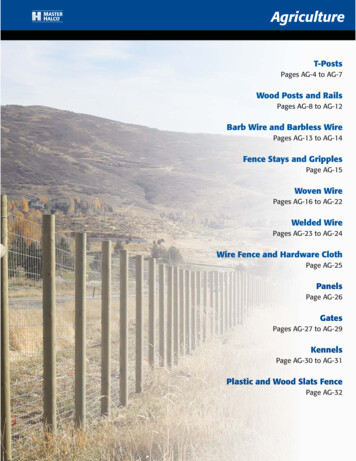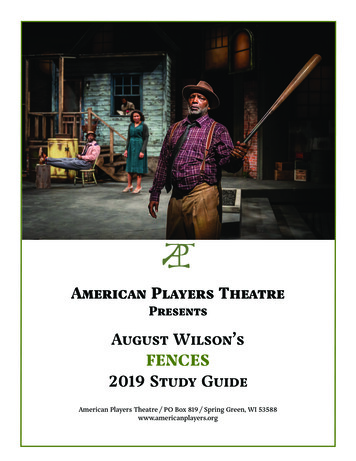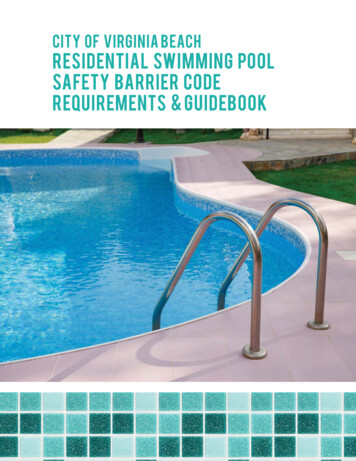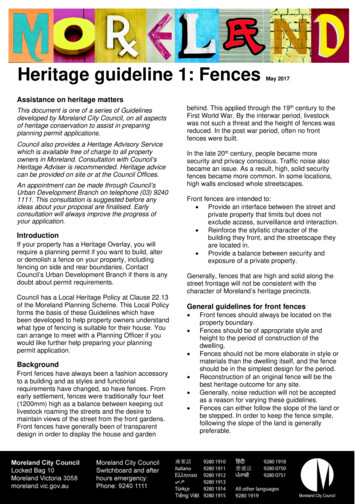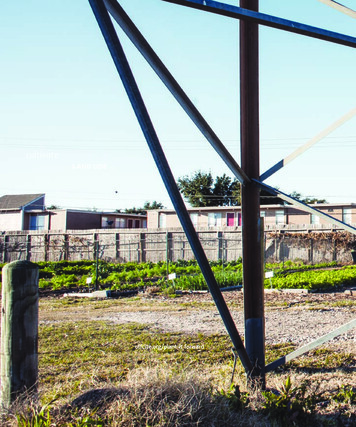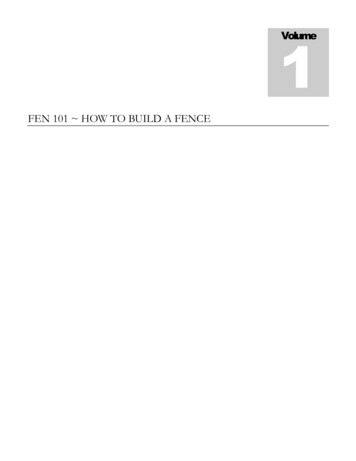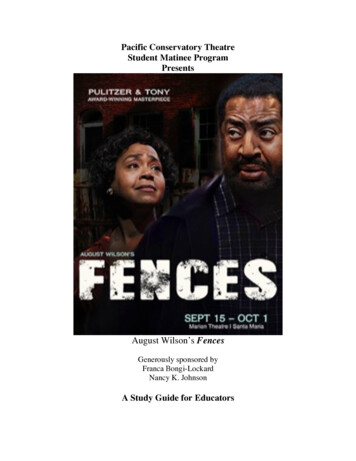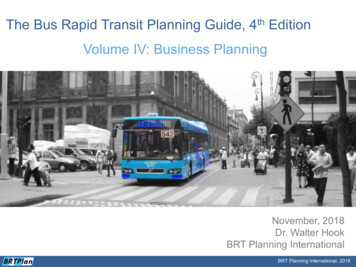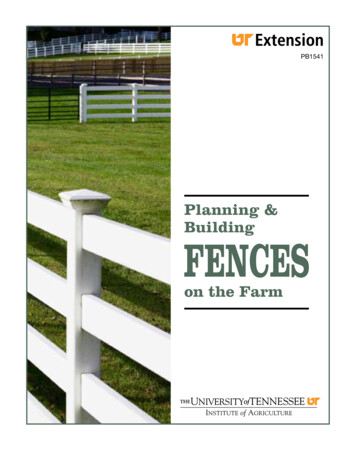
Transcription
PB1541Planning &Buildingon the Farm
ContentsPurpose of the Fence . 4Cattle. 4Sheep . 4Horses. 4Swine . 5Planning The Fence . 5Locating Permanent Fences. 5Locating Temporary Fences . 5Selecting The Proper Fence. 6Woven Wire Fences. 6Barbed Wire Fences . 6Board Fences. 7High-Tensile Fences. 7Cable Fences . 7Electric Fences . 9Comparing Fences . 9Fencing Materials and Equipment . 10Fence Posts. 10Wire. 10Staples. 11Gates . 11Electric Fence Controllers . 11Grounding . 12Lightning Protection. 12Precautions . 13Construction . 13Choosing the Fence Line. 13Corner, End and Line Brace Assemblies . 14Setting Fence Posts . 15Running Wire . 15Tensioning Wire . 17Repair and Maintenance . 17References . 183
Planning and Building Fenceson the FarmMichael J. Buschermohle, Professor, Agricultural EngineeringJames B. Wills, Professor, Agricultural and Biosystems EngineeringW. Warren Gill, Professor, Animal ScienceClyde D. Lane, Professor, Animal ScienceCattleMany innovations have occurred in the fencing industry in recent years, giving producers anarray of options for fences to confine and protectlivestock. Whether used as permanent, peripheryboundaries, temporary pasture dividers or toencircle a house, fences need careful planning andconstruction for efficient usefulness, long life andlow maintenance.Several decisions must be made when installing fencing. First, what is the fence to be used for?For example, is it going to be a boundary fence ora cross-fence to divide a pasture? Is the fence forsheep, cattle, horses or something else? Whattype of fence is best suited and where should thefence be constructed for maximum effectiveness?Other considerations include the type, spacingand setting of posts, gate location and construction, brace post assembly and installation of stockgaps or cattle guards. This publication is designed to help in planning a new or renovatedfencing system.Purpose of the FenceThe first consideration in deciding the bestfence is the purpose for which it will be used.Livestock protection and confinement are themain reasons for considering fencing, but thefencing needs for various types (species, age,breed, production system) of livestock varywidely. Following are some of the livestock typesand situations with special requirements:4Most types of fence can be used with cattle, somost cattle producers assess factors such asexpense, ease of construction and expected life ofthe fence when considering fencing strategy. Inthe past, woven wire and barbed wire were themost common fence types; however,high-tensilefencing is rapidly gaining popularity in Tennessee. Fence height for perimeter cattle fencesshould be a minimum of 54 inches.When bulls are penned separately from cows,special attention must be paid to construction.Heavy posts with thick-gauge wire or cables arerequired, or electric fence may be effectively used.Fences for handling facilities must be strongenough to withstand heavy usage, tall enough (60inches minimum) to prevent escape, and clearlyvisible. Treated wood or heavy wire panel fencesare preferred.SheepFences for sheep do not have to be as tall as forcattle, but sheep have other special requirements.Predator control is more important. Electricfences are particularly useful for discouragingpredators such as dogs and coyotes. Barbed wireis not as effective with sheep, as the barbs tend tobecome covered with wool.HorsesVisibility is a necessary characteristic in fencing for horses. Barbed wire should be avoidedbecause there are many opportunities for horses totear their hide on the barbs. High-tensile wirefences poses a threat to horses because they maybecome entangled in the strands. The chance of
this can be decreased if high-tensile fences aremade more visible by placing posts closer together, or hanging ribbons or something else fromthe wire. Board fences are ideal for horses. Woven wire also works well, particularly with asingle board at the top so the horses can easily seethe fence.SwineSwine require strong fences that are built closeto the ground to prevent them from escaping byrooting underneath the fence. Barbed wire alongthe ground helps prevent rooting. Fences need tobe no higher than 54 inches.As with cattle-working pens, fences aroundswine confinement units are likely to receiveheavy usage. Use heavy materials and sturdyconstruction for long life and functionality.Planning The FenceFencing is a costly investment. The locationand arrangement may affect production efficiency,so it makes good sense to plan before you build.This is true whether you are installing a fencearound the farm or a pasture for the first time, orreplacing an old, worn-out fence. Evaluate existing fences. If they are in good shape, you maywant to plan new fences around them. If they areold and falling down, it may be cheaper in thelong run to replace them.Pay attention to water resources when planning your fencearrangement. Wise placement offences can result in being able to use the samewater source in two, three or even three or morepastures. Fencing cattle away from ponds andusing freeze-proof overflow tanks can improvewater quality and prevent disease problemsassociated with cows standing in the pondsduring the summer. This also prevents injury anddeath due to cattle breaking through frozen pondsin the winter. Plans and information about thesetypes of watering systems may be found at yourlocal Extension office or through the Soil Conservation Service.Locating Permanent FencesPermanent fences should be well constructedusing high quality materials so they will last along time with minimum repairs. A well-constructed permanent fence that surrounds the farmis essential. It establishes a fixed property linebetween you and your neighbors and preventslosses due to livestock getting killed on the highway or having to pay your neighbors for livestockdamage to their crops. Take care to properlylocate the property line when building boundaryfences to avoid costly mistakes.Consider permanent fencing around pastureswhich will be used year after year and aroundcropland. These fences will probably never bemoved, so it makes sense to build a well-constructed, low maintenance fence that will last along time. A permanent fence is also a good ideafor a lane that gives livestock access to water.Locating Temporary FencesMovable fences are considered temporaryfences. They are normally used for a short periodof time, then removed and used in some otherlocation or stored until needed. They are easy tobuild and take down. They cost less than permanent fences, but they are not as effective andusually will not last more than one to three years.They do not take the place of permanent fences,but can be very beneficial in some instances.Temporary fences are well suited for controlled grazing situations because pastures can bedivided into a substantial number of individualcells with minimal labor and cost. They can bemoved from year to year until you decide the fieldlayout that best fits your production scheme.Locating Lanes and GatesA lane is needed to connect livestock buildings, working facilities and water with every fieldthat eventually may be pastured. Keep in mindthat a permanent pasture located between otherfields can serve as a lane.To keep gullies from forming on rolling land,plan the lane to followa terrace or natural ridge. Ifa well-drained location is not possible, use movable fences which can be relocated every fewyears. Wherever possible, locate gates and passageways for livestock and equipment in thecorner of each field closest to farm buildings. Ifyou have fields on opposite sides of a road, locategates opposite each other so livestock can godirectly across.5
Selecting The Proper FenceThere are many types of fences to meet various fencing needs. Since fencing usually represents a rather large investment on most farms, it isespecially important to select a fence that isaffordable, easy to maintain, durable and, mostimportantly, keeps livestock in. The kinds offences commonly used in Tennessee includewoven wire, barbed wire, high-tensile, board,electric or a combination of any of these.Design #HorizontalWiresHeight 1561156Woven Wire FencesWoven wire fences consist of a number ofhorizontal lines of smooth wire held apart byvertical wires called stays. The distance or spacing between horizontal line wires may vary fromas close as 1 1/2 inches at the bottom for smallanimals, to as wide as 9 inches at the top for largeanimals. In general, the spacing between wiresgets wider as the fence gets taller.Woven wire is available in many combinationsof wire sizes and spacings, as well as a number ofhorizontal line wires and fence heights. Theheight of most woven wire fencing materialsranges from 26 to 48 inches. The fence heightshould be selected based upon the animals sizeand their jumping ability. Stay wires shoiuld bespaced 6 inches apart for small animals and 12inches for large animals.The standard design numbers listed on the tagdescribe the wire. Forinstance, a design number1047-12-11 indicates thewire has 10 horizontalwires and is 47 inches high,stays are spaced 12 inchesapart and stay-and-fillerwires (wires between thetop and bottom line wires)are 11 gauge wire. The topand bottom wires aregenerally two sizes larger.Standard woven wire fencesizes are shown in Table 1.Table 1. Common Woven Wire Fencing MaterialBarbed Wire FencesBarbed wire fences are made of two or morestrands of smooth, galvanized-coated, steel wiretwisted together with two or four barbs spacedevery 4 to 5 inches. They are generally classifiedas either a standard or suspension barbed wirefence.Standard barbed wire fences usually havethree to five strands of barbed wire stretchedbetween posts that are spaced between 15 to 25feet apart (Figure 1).The suspension fence has 4 to 6 strands ofwire stretched taut so there is no more than 3Figure 1. Common Spacings in Barbed Wire Fences6
Figure 2. Suspension Barbed Wire Fenceinches of sag between posts (Figure 2). Depending upon the topography, line posts are generallyspaced between 80 to 120 feet apart. The wires areheld apart by twisted wire stays spaced 16 feetapart. Wind or animals hitting the fence cause itto sway back and forth. This swaying motionkeeps animals away from the fence and discourages them from fighting through it. To allow thefence to sway, the stays must not touch theground or the effectiveness of the suspensionfence will be reduced.High-tensile fences are constructed mostlywith 12 1/2 or 14 gauge Class 3 wires which havetensile strengths from 170,000 to 200,000 or morepounds per square inch (psi) and breakingstrengths of approximetly 1,800 pounds (Figure 3).This fence can withstand more than 1,100 poundsof livestock pressure without losing its elasticity,yet it is flexible enough to bend, wrap, tie in knotsor clamp with crimping sleeves. Wires are held intension along wood, fiberglass, insulated metalposts or a combination of posts and battens ordroppers. Tension in the wire is maintained bypermanent in-line strainers. Adequate tension for12 1/2 gauge high-tensile wire is 200 pounds. Atension indicator spring is used to indicate wiretension.High-tensile wire fences should be used withelectricity to improve animal-holding capabilityand predator control. It is important to usetreated wood posts and set them properly in theground with adequate braces to withstand thepressure caused by the tightly stretched wire.Board FencesBoard fences are very attractive, quite strongand are safe for animals. They are typically usedas border fences around the farm or the home.Board fences consist of 1- to 2-inch thick, 4- to 6inch wide boards nailed to wooden posts spaced 8to 10 feet apart. They can be built to any height,however, heights of 4 to 5 feet are most common.The price of lumber, nails, paint and othermaterials along with the labor required makes thecost of these fences considerably higher than mostpermanent wire fences. Upkeep is also high,especially if untreated lumber is used.High-Tensile FencesAn increasingly popular type of fence is hightensile wire fence. First used in New Zealand andAustralia, high-tensile wire fences offer severaladvantages over conventional fencing: easier to construct last longer cost less to build than mostconventional fences require less maintenanceFigure 3. High-Tensile FenceCable FencesBecause of their expense, cable fences are usedprimarily for confinement areas, such as holdingpens, feed lots and corrals. These fences usuallyconsist of 3/8-inch smooth steel wire cablesstretched between anchor posts. The cables arenormally made out of seven wires twisted together. Heavy duty springs are placed at one endof each cable to absorb the shock on the wirescaused by animals pressing against them. Cablesare usually passed through holes in wooden orsteel posts.There is no limit as to the number of cables7
Table 2. Comparison of Common Fences8
that can be used; however, a six-cable fence isoften used for large animals. The spacing between cables depends upon the type of animals tobe confined.Electric FencesElectric fences are widely and successfullyused in Tennessee. They can be an effective, safeand inexpensive means of providing both temporary and permanent fencing if they are constructed properly and energized with a properlysized controller.Electric fencing does not need to be strongbecause it seldom comes under pressure, but itmust be well designed and constructed to absorbthe impact of animals. It is also essential thatthere is adequate power for the length of fencingand the type of animals to be confined. Severaladvantages of electric fencing are low cost, inexpensive to operate, can be used to extend the lifeof old permanent fences or they can be used fordeer and predator control. They can be built fortemporary or permanent use.Various types of inexpensive, easily-erectedtemporary electric fences are available. Probablythe most popular are the polywire strands orribbons which are fine wires woven together withpolyethylene fibers.Polywire comes in various colors. Black is themost difficult for animals and people to see.Brighter colors, such as orange or white, are alsoavailable. The polytape, particularly the extrawide type, is easier to see than polywire. Thistype works better for horses. It is very importantto keep weeds and grass cut away from the fence,especially when using low impedance controllers.If grass and weeds are allowed to touch mostpolywires, the charge produced from low impedance controllers can cause the small-diameterwires to burn in two. Polywires with stainlesssteel wires are more durable, but electric conductivity is lower. Aluminum conducts electricitybetter, but it breaks more easily.Aluminum, stainless steel and high-tensilewire can also be used. One advantage to usingthese type of wires is they conduct electricalcharges for longer distances than the smalldiameter wires of the polywire and polytapes.However, they are harder for the animal to see. Toeffectively train animals to stay within an electricfence, the animals need to see the wire as they feelthe shock. Tying pieces of white cloth or brightlycolored plastic ribbon will help make these wiresmore visible.An electric fence controller is used to energizethe wire. The moist earth is used for completingthe electrical circuit. Corners and end posts intemporary electric fences require minimal bracing.Line posts can be small and spaced far apart sincethe fence will generally be used for a short periodof time.Comparing FencesAs previously stated, when selecting a fence,the things to consider are what the fence is to beused for, how easy it is to build, what it costs tobuild and maintain and how long it is supposedto last. Table 2 gives some general comparisonsPost TypeBendingstrengthExpectedlife (yrs)InitialcostFireresistanceMaintenanceSteel-T, concreteFair25-30MediumGoodLowSteel rod 3/8" diaPoor15-20LowGoodMediumHeavy-duty fiberglass-TFair (flexible)25-30HighPoorLowLight-duty fiberglass-TPoor (flexible)15-20LowPoorMediumPressure treated woodGood30-35MediumPoorVery LowUntreated woodGood7-15LowPoorHighTable 3. Fence Post Characteristics9
KindUntreatedTreated(Pressure)Treated(Soak)Osage O.25-35 yrs--FenceSpacing(feet)R. Cedar15-25 yrs20-25 yrs20-25 yrsWoven Wire14 - 16B. Locust15-25 yrs--Barbed Wire12 - 14W. Oak5-10 yrs20-30 yrs15-30 yrsSuspension100Hickory2-6 yrs15-20 yrs10-15 yrsElectric40 - 75R. Oak2-6 yrs20-30 yrs20-30 yrsHigh Tensile40 -60Y. Poplar2-6 yrs20-25 yrs15-25 yrsBoard8S. Gum3-6 yrs20-30 yrs20-30 yrsCorrals6S. Pine3-7 yrs25-30 yrs15-20 yrsTable 4. Life Expectancy of Wood Postsyou can use to help select the type of fence thatbest fits your need and budget.Fencing Materials andEquipmentFence PostsThere are many types of posts available inTennessee (Table 3 ). Always try to find the bestpost to meet the demands of the situation. Forexample, it is best to use good, treated posts forpermanent peripheral fences, while light fiberglass or steel posts would be more suitable forconstructing temporary fences in a controlledgrazing cell.Often the least expensive option is to cut yourown posts or purchase untreated, wooden posts.They are highly variable in size, shape and durability (Table 4 ). Osage orange posts have alifespan of 25 to 35 years, black locust or red cedarposts will last for 15 to 25 years. Other woodssuch as oak, pine and poplar will rot in just a fewyears unless they are pressure treated.Wood posts come in an array of sizes andlengths. The larger the top diameter, the strongerthe post. Corners are the backbone of a fence.Whether you plan to install a woven wire, barbed10* Driven posts are 1.7 times as strongas tamped postsTable 5. Recommended Post Spacings*wire or high-tensile wire fence, the first step is tochoose good corner posts. Corner and gate postsshould have a diameter of at least 8 inches. Braceposts should be 5 inches or more in diameter.Line posts can be as small as 2 1/2 inches, butlarger diameter posts will make the fence strongerand more durable.Steel posts have several advantages. Theyweigh less, can be driven into the ground rathereasily, won’t rot and are fireproof. They also helpground the fence against lightning when the soil iswet. They aremore likely to be bent or forced outof line by livestock. A widely used method is touse wooden line posts every 50 to 75 feet to helpkeep steel posts from bending and improve thestrength of the fence.All posts must be long enough to accommodate the height of the fence and depth of setting.To get the correct fence post length, add togetherthe depth of setting, the height of the top wire and6 extra inches. Recommended post spacings forvarious fences are shown in Table 5.WireWire is covered with zinc, commonly calledgalvanizing, to protect it from rusting. The lengthof time before fence wire begins to rust dependson the thickness of the galvanized coating. Themore ounces of zinc per square foot of wire means
more years of service before rustingstarts (Table 6).Fence manufacturers and theClimatic ConditionsAmerican Society for Testing MateriDryHumidals have established “classes” of zincClass 1Class 3Class 1Class 3coatings for fence wire. Class 1 hasthe lightest coating of zinc and ClassWire SizeYears until rust appears on the wire3 has the heaviest. Because of91530813competition, many local fencingsupply dealers only stock wire with111130613Class 1 coating. Fencing materials12 1/21130613with Class 3 coating may have to bespecially ordered. Galvanizing14 1/2723510delays rusting. The more galvanizing on the wire, the longer it will beTable 6. Approximate Prootection Given Wirebefore rust starts to appear.by Class 1 and Class 3 GalvanizingOnce steel wire starts to showrust, it isn’t long before the wholefence is rusted. It usually takes fromone to three years from the time rust first appearsmaterials, including heavy pipes, railroad railsuntil all the wire is rusty. The durability of theand wooden beams.fence then depends on how fast rust weakens thewire. Rusting slowly reduces the diameter of theElectric Fence Controllerswire. As the diameter of the wire gets smaller, itsMost producers will agree that touching anstrength is reduced.electric fence is very unpleasant. The experiencefor animals are no different. When animals comeStaplesin contact with an electric fence, the shock theySelecting the appropriate staple is just asreceive affects their nervous system. The severity,important to the overall strength and longevity of or the amount of shock the animal feels, dependsthe fence as selecting the right wire. Staple pullon the voltage and amperage as well as the duraout is a common fencing problem when usingtion of the shock. It takes a minimum shock of 700pressure-treated softwood posts. The lubricatingvolts to effectively control short-haired breeds ofaction of the preservative, combined with the softcattle, pigs and horses, and around 2000 volts fornature of the wood, makes it easy for staples tolong-haired cattle, sheep and goats. The controller,loosen and fall out over time. To avoid thisoften referred to as the charger or energizer, thatpulling-out action, use 1 3/4-inch or 2-inch long,delivers this shock is the heart of any electric fence8- or 9-gauge, hot-dipped, galvanized staples with and must be selected carefully. There are twocut points and barbs. If you are using untreatedtypes of controllers currently on the market: highhardwood posts, shorter staples can be usedand low-impedance controllers.because they cannot be pulled out of hardwoodElectric fence controllers of years ago, andvery easily.some brands today, put out relatively high voltagewith low amperage. These are known as highGatesimpedance controllers. Because of their highvoltage and low current output, there is no stayAlways place gates in logical places so liveing power of the charge. The first weed or bladestock will move through easily. Avoid puttingof grass to touch the fence will drain the power togates in the middle of a straight fence. It is bestthe extent that little or no shock is felt by thetoput them in corners. Build or buy sturdy gateanimal, after even a short distance of fencing.materials, especially hardware items such asLow-impedance controllers have the capacityhinges and closures.topowerlong distances of single or multi-wireStock gaps or cattle guards are useful for hightraffic areas. Cattle guards can be made of various fence. These controllers put out a lower-voltage,11
higher-amperage charge. Their pulse is extremelyshort compared to high-impedance controllers.Since the pulse length is short, the conductivecapacity of the wire isn’t saturated. Consequently,there is less impedance or resistance to currentflow, resulting in more livestock-influencingenergy delivered over miles of fence that weedsand grass won’t short out.If all the fields you plan to fence are not near a120-volt power source, you have no choice but touse a battery-operated controller. They do anexcellent job of confining animals and are verypopular controllers because they can be used atany location without connection to a 120-voltpower source. These controllers operate on eithera 12, 24 or 36 volt (1, 2 or 3 batteries) system. Thebatteries can be disconnected from the controllerand recharged every two to six weeks dependingon the type of charger and the amount used. Witha solar energy collector kit, thebattery can berecharged daily for the life of the battery. Deepcycle, marine and RV type-batteries are best suitedfor battery-operated controllers. Batteries designed for use in automobiles will not last as longas deep-cycle batteries.If your fields are near where they can beserved by a 120-volt controller, it is probably yourbest selection. There is no problem of changing orrecharging batteries and they cost less than thebattery-operated controllers equipped with solarkits. Cost of operation is reasonable, averagingaround 50 cents a month.For good animal control, it is important tomatch the capacity of the controller to the fenceyou want to charge. Most manufacturers indicatethe strength of the controller by the number ofmiles it will power. A good rule of thumb forsizing controllers is to determine the number ofmiles of electrified wire in the fence and add 25percent to offset any power drain caused by grassand weeds touching the fence. For example, ifyou have a 5-mile long, 6-strand high-tensile fenceand four of the wires are electrified, you wouldneed a controller rated at a minimum of 25 miles(4 x 5 20 25% 25).GroundingGrounding is very important when usingelectric fence controllers, especially with the lowimpedance types. A minimum of three, 6-footlong galvanized ground rods driven in the ground6 feet apart and tied together with a #12 gauge12copper wire are required for the smaller units(Figure 4). If rocky ground prevents the rods frombeing driven into the ground, it is recommendedthe rods be laid end to end in a deep trench andtied together with the copper wire. More powerful units may require a minimum of eight rods.Check manufacturer’s recommendations forproper grounding procedures. Make sure groundrods are at least 50 feet from any utility companyground rod, underground telephone or powercable. Firmly attach the ground wire to each rodwith ground clamps.Figure 4. Grounding Electric Fence ControllersLightning ProtectionLightning strikes are a major problem withelectric fences. It is rather common for lightningto hit a wire fence directly or indirectly through atree or building near the fence, and then travel asfar as two miles on the fence before it is grounded.Whenever possible, disconnect the charger fromthe fence line during a thunderstorm.The best and least destructive way to prote
the wire. Board fences are ideal for horses. Wo-ven wire also works well, particularly with a single board at the top so the horses can easily see the fence. Swine Swine require strong fences that are built close to the ground to prevent them from escaping by rooting underneath the fence. Barbed wire along the ground helps prevent rooting .
